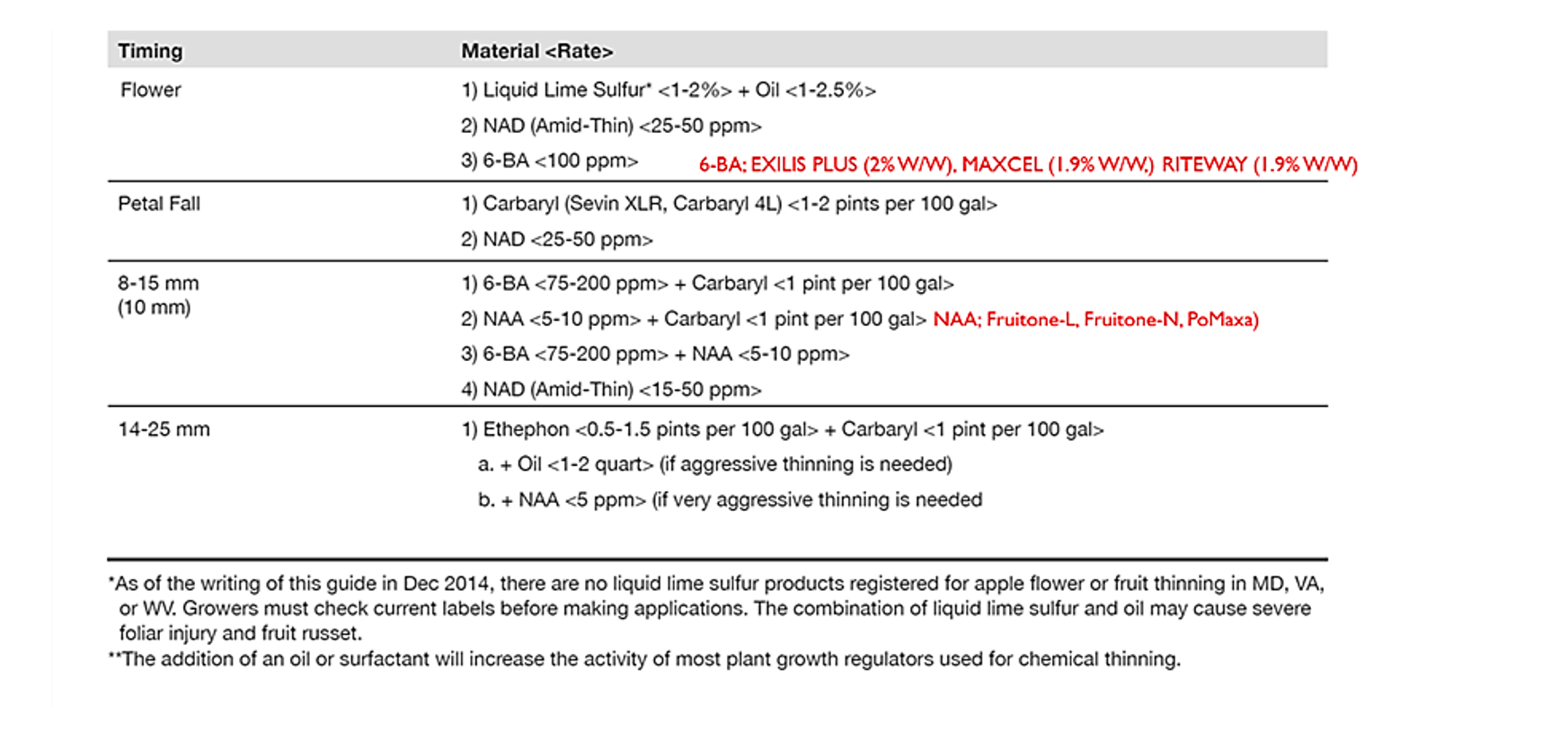In modern apple production systems, chemical thinning of young fruitlets within the first four weeks after petal fall has become a key management element. Inadequate thinning of fruit during this period increases the need for hand thinning, which is generally more laborious and expensive. On the other side, if trees are left without thinning at all, the chances of having low quality fruits and less return bloom in the following year are very high. To achieve adequate thinning using chemical thinners, many factors should be taken into consideration. These include, but are not limited to, fruit size, carbohydrate reserve status of the tree, weather conditions and -to a lesser extent- variety sensitivity. As a general rule, sunny days and cold nights promote the accumulation of photoassimilates and consequently trees become less prone to shed any of their fruits and are less sensitive to thinning applications. Whereas, cloudy days and warm nights lead to carbohydrate deficit and therefore trees tend to retain only a limited number of fruits and become more sensitive to chemical thinning. This associating between weather conditions and the total carbohydrate reserve has encouraged scientists (Alan Lakso and Terance Robinson) at Cornell University to establish a model known as “The Cornell Apple Carbohydrate-Thinning Model” that provides instructions on the dose and timing of thinning applications based on the solar radiation, temperature and day length records acquired from a weather station in a grower’s orchard blocks. This model can be accessed online through the Network for Environmental and Weather Applications (NEWA)(http://newa.cornell.edu/index.php?page=apple-thin).
It is a good practice to visit the NEWA website and make yourself familiar with the inputs and outputs of this model, especially if you have a weather station in your orchard that is connected with NEWA server, or you know the one that is close to your operation and that you can depend on.
As we are moving toward a heavy crop load and, luckily, less frost damage for apples this year, we have to consider looking at the outputs of the carbohydrate model in order to decide the timing and the dose of the chemical thinner. Typically, the efficiency of thinning applications applied from petal fall until a fruit size of 20 mm correlates well with the carbohydrate reserve of the tree and these are the times where the model outputs will serve as useful guidelines.
This year, we, at AHS Jr. AREC, Winchester, will run the model weekly and provide the outputs of this model as graphs that show the carbohydrate reserve of apple trees, and the recommended applications. The following table (Table 1) describes the recommended dose of chemical thinners based on the carbohydrate balance of the tree.
Table (1): Decision rules for using the output of the carbohydrate model to adjust chemical thinning rate.

Fruit size is another major factor that determines the efficiency of chemical thinning. When fruits are young (~ 6 mm), their demand of carbohydrate is not much and hence thinning becomes relatively challenging. However, chemical thinners such as naphthaleneacetic acid (NAA) and Sevin (carbaryl) and, to some extent, naphthaleneacetamide (NAD; Amid-Thin) can be successfully used at this stage. As fruits grow to the size of 7-14 mm, their cells divide rapidly and their demand of carbohydrate becomes more than what vegetative tissues can supply, especially if weather conditions do not largely support photoassimilation. At this stage, fruits become more sensitive to chemical thinners such as 6-benzyladenine (6-BA), NAA and NAD. However, if thinning is not adequate at this stage due to unsuitable weather conditions, then another round of thinning application will be essential. As fruit develops to the size above 20 mm, the chemical thinning becomes a tangible challenge. At such an advanced stage of development, fruits become more tolerant to abscission as they have more carbohydrate reserve and the seeds produce auxin which interferes with ethylene action preventing abscission. Chemical thinning at this stage (known as delayed/ rescue thinning), relies mostly on the combined application of 2-chloroethylphosphonic acid (ethephon) and 1-naphthyl methylcarbamate (carbaryl). The following table (Table 2) shows the recommended thinning applications in each stage of flower/fruit development and the dose of each application.
Table (2): Materials, rates and timing of chemical thinning application (Source:2017 Spray Bulletin for commercial tree fruit growers).

